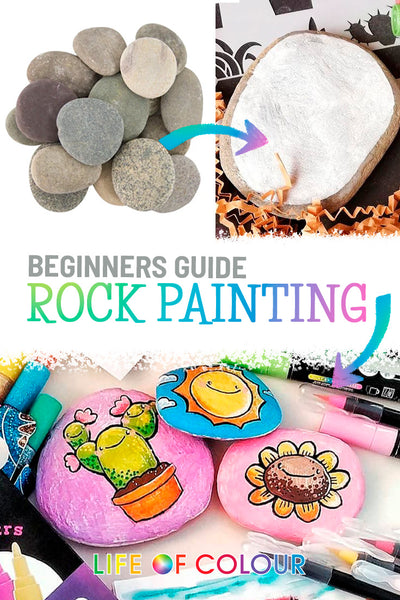How to prime your rocks for rock painting
Priming your rocks before you start painting is important for two reasons: the surface will be smoother and less porous, but still porous enough to absorb paint permanently (as opposed to a polished rock, ceramic or glass for example).
This will help you in the painting process, less coats of paint and less damage to your paint pen nibs and/or brushes.

Why use a primer and not just the paint pens?
Using a primer before rock painting evens out the surface of the rock and gives it a nice light background to paint on and make colours pop a bit more.
Also, and most importantly, it helps with the application of the paint so the rock is not scratchy or bumpy.
Without the primer, most rocks’ surfaces work as sandpaper on the nibs of paint pens and brushes’ bristles. After a while you'll start noticing the nib lost it's round tip and it has become flat and scratchy.
How do you prime a rock for rock painting?
Wash your rocks to remove any dirt or dust before starting. Let them dry and then you have an option of sealing or priming the rock to make a nice smooth surface to the rock.
There are a few spray primers for rock painting you can shop online or in a hardware store. You can use a spray primer or a brush on primer/undercoat from Dulux or British Paints brands.

Do one side at a time and make sure the entire coat of primer is dry first before starting to paint.
To use a spray primer to prime your rock, spray a few cm away from the rock.1 coat should be enough.


Another option is priming with white acrylic paint using a broad acrylic brush. Take the opportunity and prime a batch of rocks at the same time to make the process speedier for you.

Casey Smith explained her process for these beautiful pastel backgrounds in Life of Colour Art Group: "the background colour is acrylic paint mixed with a pot of white that I got from Bunnings. I always add the white because it makes the paint thicker (easier to spread and you don’t have to do anymore then 2 layers) and the colours nicer for a background"
What colour to use to prepare rocks for painting? Base colour or clear?
Priming rocks with a white base coat for brighter colours or clear coat for darker shades of colour.

Why do people prime their rocks?
To preserve your acrylic paint pens. Priming evens out the surface of the rock, which helps with the application of the paint and keeping your paint pens nibs healthier for a long time. If your nibs do get damaged, you can buy replacement paint pen tips here.

Do you need special paint for rocks?
If you even wondered "what paint to use on rocks?" look no further, acrylic paint pens are the best of both worlds when it comes to rock painting, improving the colour palette, mixing options, opacity and durability compared to Sharpies for rock painting and dollar store acrylic paint pens while keeping the fantastic silky matte texture from acrylic paints.
Not everyone has the agility to paint small spaces with a paintbrush, but we all know how to use a pen! These pens are filled with acrylic paint so they will look exactly the same as if you applied paint with a brush, but will be a lot easier for most people. They are also mess free and portable, so you can take all your rock painting tools with you outdoors.
Now the fun part! We believe the easiest and best way to paint rocks is with Life of Colour acrylic paint pens! Getting acrylic paint pens in Australia and New Zealand is very easy now, we deliver to your door all the rock painting supplies you need to get started.







4 Responses
I want to learn more about painting rocks and stones and acrylic paint pens, cannot find it here in Namibia.
How can I order for rock painting supplies
How can I order for rock painting supplies
Just a 60 year old -beginner,, any tips welcome ✅😀